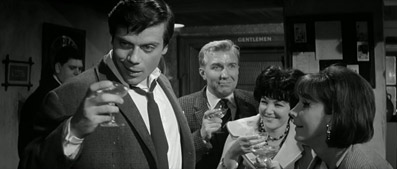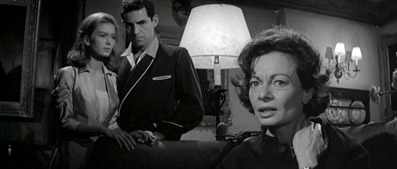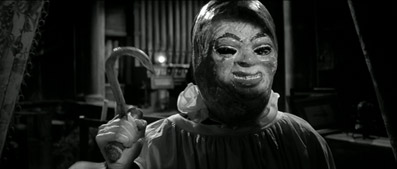| "I've been drinking. Now I'm going to drink some more." |
| Simon Ashby, played by Oliver Reed, an
actor also partial to the odd tipple |
I've always had a soft spot for Oliver Reed. He was, I believe, an underrated actor whose considerable ability and commanding screen presence was too often sidelined in favour of colourful stories about his heroic drinking. Mind you, it was Ollie's fondness of the odd pint that enabled Rex, a now sadly departed close friend of mine, to meet the man he regarded as one of the country's most precious talents, and to discover that despite his staunchly conservative views and fondness for wild living, Reed was also be something of a gentleman.

Allow me to eleborate. What would probably take a few seconds on Google nowadays took a little more effort in pre-internet times, but Rex discovered the name and location of Reed's local pub and installed himself there one Saturday in the hope that the big man would drop by. When he did, my friend introduced himself and offered to buy Ollie a drink, which he graciously accepted, and the pair spent a most cordial hour discussing Reed's career and The Devils in particular. So star-struck was my friend that a couple of weeks later he went to watch Reed play in a celebrity golf tournament, despite his disinterest in the sport itself. As the actor completed his game and was walking off the green, he was flanked by a gaggle photographers and autograph hunters. Yet in the midst of this kafuffle he caught sight of my friend standing amongst a huddle of other spectators and walked through the reporters, stuck out his hand and said with genuine warmth, "Hello Rex! How are you?" What a guy.
Now you may well presume that a rambunctious lifestyle would prove excellent preparation for drunken screen acting, and if so then Reed's role in the 1963 Paranoiac must have seemed something of a dream ticket. Paranoiac was made by Hammer Films, who although more widely known for their remakes of classic Universal gothic horrors, during the early-to-mid 60s did a rather nice sideline in psychological thrillers. With a single exception (the 1965 Fanatic), they were all written by Jimmy Sangster and all shot in black-and-white, which both separated them from their famously colourful gothic brethren and more closely aligned them to the likes of Psycho and Les Diaboliques. Paranoiac, written by Sangster and directed by cinematographer-turned-director Freddie Francis, is a solid example of this sub-genre, one driven by a plot twists that are devious enough to keep even a sympathetic modern-day audience on their toes.

This was not Reed's first role for the studio and it's fair to say that it was Hammer that gave him his first real breaks. He graduated from a bit part in the 1960 The Two Faces of Dr. Jekyll to leading man the following year in The Curse of the Werewolf, which is still regarded as one of the best of all werewolf films, not least for the intensity of Reed's performance. Paranoiac showcases the young actor at his best in a performance whose confidence and authority clearly signposts the direction his career would subsequently take. Here he plays Simon Ashby, the son of wealthy parents who died eleven years previously and whose money and property he and his sister Eleanor (Jeanette Scott) are soon due to inherit. But all is not well in the Ashby household, as Simon is squandering money he doesn't yet have, and Eleanor has never recovered from the past suicide of her brother Tony. Nominally responsible for the pair is their cheerlessly protective Aunt Harriet (Sheila Burrell), while attractive French nurse Françoise (Liliane Brousse) is on board to take care of Eleanor and keep Simon company on those cold winter nights, much to Auntie's stern disapproval. Simon thinks that Eleanor should be committed, which would leave him the sole beneficiary of his parents' estate, a plan that's upset when the adult and very much alive Tony (Alexander Davion) walks through the door of the family home.
And that's all the plot you should have in advance, given that the narrative's prime purpose is to keep you guessing, and it certainly does that. Anyone familiar with Hammer's psychological thrillers will know from Tony's first appearance that there'll be a logical explanation for this apparent resurrection, while the Hitchcock-aping title indicates we're dealing with madness rather than the supernatural. But through some neatly devised plotting and well timed red herrings, the film effectively sustains the mystery right up to the pleasingly grotesque final twist. Impressively served by Arthur Grant's excellent monochrome scope camerawork and Freddie Francis's knack for eye-catching camera placement (a shot of Simon that is filmed through water is particularly memorable) and unsettling imagery (the masked figure that attacks Tony is a lot creepier than any written description would make it sound), Paranoiac shines in a handful of smartly done set-pieces, including a nail-biting sequence involving a car, a wire fence and a very high cliff top, a scene whose sharp handling comfortably survives any matte work imperfections.

As suggested by the poster and the exclamation mark it adds to the title (a title that appears in the film itself in sober text and shorn of this loud punctuation), the film has is moments of high drama and sensation, but for the most part restraint is the order of the day, and when the characters do lose their cool then we can be thankful that performers of Reed and Scott's caliber are on hand to sell the anger and hysteria as real. Less widely seen than the studio's gothic horrors, Paranoiac is a smartly plotted, tautly handled and enjoyably performed old school psychological thriller, one that plays with adult themes and whose characters trade in emotional rather than physical violence. A most worthy DVD resurrection from Eureka, I'd say.
| the cuts, whatever they may be... |
|
As far as I'm aware this is the same edit of the film that was released in cinemas back in 1963, or at least American cinemas – the transfer here appears to have been sourced from an American master, identified by the Universal International logo at the film's front end (it was distributed by Rank in the UK). I've been unable to confirm whether any cuts were made specifically for the US market, but the BBFC web site notes that the film was awarded an X certificate and that "to obtain this category cuts were required but details are not available."
The running time of the version originally submitted to the BBFC was logged as 80 minutes and 29 seconds, a mere 11 seconds longer than the version on Eureka's DVD, which as an NTSC disc has been transferred at the correct speed of 24fps. While the precise details of the trimmed material remain uncertain, it's reasonable to speculate that it constituted a single cut of about 11 seconds, based on the running time difference and a very visible continuity jump that occurs 45 minutes and 44 seconds into the film.
The scene as it is plays like this. Simon arrives home drunk and is led to his bedroom by Aunt Harriet, who plonks him on the bed, makes him comfortable and starts to undo his shirt. Simon at this point is unconscious with his head turned to the side. The scene then cuts to a closer shot of the same, but Harriet's physical position is more intimate in relation to Simon, who is looking directly at her and wearing a lascivious grin, which she reacts to by immediately leaving the room. Now while it's just about possible to pass this off as a continuity error, it's not just the position of the characters that's different but the lighting, which in the second shot betrays the presence of an off-camera lamp that provides side light not present in the first part of the scene. And sorry, but with one accomplished cinematographer behind the camera and another in the director's chair, it's hard to believe such a lighting continuity error would be allowed to occur.
|
The edit point in question – the shot above cuts immediately
to the shot below. Spot the differences? |
|
While it's hard to be sure exactly what took place in the missing seconds that could so upset the British censor, I'm guessing that it involved a strong inference of incest, still a taboo subject today and a definite no-no back in 1963. It's not the only time the film flirts with the subject, but the incident that remains, though upsetting for one of the characters involved, is rendered morally 'safe' for the viewing audience. I shall say no more.
A top notch restoration and DVD transfer that really pampers Arthur Grant's handsome monochrome scope cinematography, with a strong contrast range and little or no detail lost to retain the inky black levels, even in night scenes, which have been lit for clarity without sacrificing atmosphere a jot (Grant was a Hammer regular whose CV includes The Curse of the Werewolf and Plague of the Zombies, as well as Tomb of Ligeia for Roger Corman). I've not seen the Blu-ray release, but given the quality of the transfer here, my hopes are high for that version.
There's something about the soundtrack of a Hammer movie, from the recognisable scores (the one here is by Elisabeth Lutyens, who two years later provided the music for Dr. Terror's House of Horrors for Amicus) to the pacing and use of sound effects, that make them as much part of the studio identity as their more celebrated visuals. The period in which they were made – Hammer's output peaked in the 60s – also provides a degree of sonic continuity, largely mono tracks with a slightly narrowed tonal range that nonetheless allowed for some extremes of volume, from gentle whispers to musical crescendos, without falling victim to distortion or clarity issues. In this respect, Paranoiac could safely be described as having a typical Hammer soundtrack, and I mean that in an affectionate way, one that is nicely handled by the DVD, being clear and free of noise or distortion.
English subtitles for the hearing impaired have been included.
The only extra here is a Trailer (2:35), which is narrated with restrained sensationalism by what sounds like Professor Quatermass as played by Brian Donlevy.
A nicely written, solidly performed (in my appreciation of Reed, I've not given Sheila Burrell the credit she deserves, or even mentioned the always reliable Maurice Denham), atmospherically photographed and smartly directed example of Hammer's psychological thriller strand at close to its best. Although light on extras – well very light, as it happens – to see a less well known Hammer film looking this good, even on DVD, is a sound enough reason to recommend the disc. And I may be wrong, but is this the first Hammer movie to get the Blu-ray treatment?
|